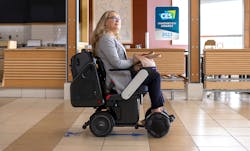Inclusive Mobility in Airports: Self-Driving Mobility Chairs Change the Way Passengers Move through Airport Terminals

With labor shortages and technology advancing rapidly, airports and airlines across North America are adopting new mobility services like autonomous (self-driving) power wheelchairs or manual power chairs that are operated by passengers needing assistance. These innovations reduce the need to fulfill wheelchair push requests and allow airline passengers to travel more freely by autonomously transporting them to their gates or allowing them to ‘drive’ themselves. While at first glance this may seem like a novel innovation – interesting, but not necessary – the changing landscape of the airline industry and the demographics of its passengers make the adoption of this technology imperative for all airports, regardless of size and location.
Mobility is a Significant Business Problem
Providing quality service to passengers with reduced mobility is one of the most common challenges affecting airports and airlines today. These travelers are the fastest-growing demographic in the airline industry, and airports are struggling to meet the additional demands that come with accommodating their needs. This includes more wheelchair pushes, longer wait times and an increased number of staff injuries. These issues are further compounded by rising operating costs and tight labor markets. Additionally, many passengers find existing wheelchair push services to be less than ideal and desire more independence when navigating the airport.
At the large majority of airports, the current approach to transporting passengers who need assistance is primarily in the form of a wheelchair push service. However, as the population ages, the demand has increased, requiring airlines or airports to hire more staff to facilitate wheelchair push services. Meanwhile, it has become increasingly challenging to find, train, and keep staff who can provide the service required to meet the growing demand. Demand increasing; supply decreasing. Sounds like a problem?
The Current Approach isn’t Effective (or Sustainable)
Clearly, the majority of passengers navigate through the airport on foot. However, it’s estimated that due to the aging population, one in three travelers will need some form of assistance by the year 2038. The recovery of the travel sector following the pandemic is putting additional pressure on wheelchair push services as people return to traveling more frequently.
What is the potential cost to airports and airlines when operations don’t run as they should, or more importantly, as they could? One only has to look at the recent example of a major carrier canceling hundreds of flights in 2022, the resulting public backlash, and the effect on the airline’s reputation and sales
While there is no effective way to determine how many flights are missed or delayed because of passenger mobility needs, anecdotal evidence from airport operations managers suggests there is a significant opportunity to close the gap between passenger demand for assistance and the airports’ capacity to deliver that assistance. Augmenting the wheelchair push service with autonomous service reduces the burden on staff and contributes to improved overall service to customers.
How Autonomous Chairs Work
The WHILL Autonomous Service allows passengers to be transported to their boarding gate using an autonomous mobility vehicle and a touch panel. The service is easy to use and requires only a few button presses. Users select their destination on a touch screen and then press “start” – the chair does everything else. In some airports, the system is set up to allow passengers to make additional stops at predetermined locations such as restrooms, shops, and restaurants.
This service allows all customers to move through the airport with ease, including the elderly, those who normally need wheelchair assistance, and anyone who is concerned about walking long distances due to their physical strength.
Upon arrival at the gate, the user gets off the chair, and the chair automatically returns to its home station, ready to help another person. Chairs can also be programmed to pick up passengers at arrival gates or transport passengers from gate to gate during layovers.
Safeguards for Self-Driving Chairs
The development and deployment of the WHILL autonomous system have been subject to rigorous safety testing and regulations to ensure passenger well-being. The implementation of these safety features is essential to providing a secure autonomous chair service in airports. WHILL has carefully designed the following important safeguards for the autonomous chair service:
- Collision Avoidance: Autonomous chairs are equipped with sensors to detect and avoid obstacles in their path. These sensors provide real-time data to help the chair navigate safely and engage automatic brakes to avoid collisions.
- Path Planning and Mapping: The autonomous chair service pre-maps the airport's layout and develops a path-planning algorithm to ensure safe and efficient navigation. Path planning takes into account factors like passenger traffic, restricted areas, and potential hazards.
- Emergency Stop Button: A prominent emergency stop button is provided for passengers to stop the WHILL autonomous chair in case of emergencies or unexpected situations.
- Redundancy and Backup Systems: Critical components of the autonomous chair system, such as sensors, control systems, and power systems, have redundancy or backup mechanisms to ensure continued, uninterrupted operation.
- Monitoring and Supervision: The autonomous chair service has a monitoring system in place to remotely supervise and control the chairs, ensuring smooth operations and addressing any issues promptly.
Improvements in Airport Operations
Airports such as YWG, HND, and NRT have successfully implemented autonomous wheelchair services, proving the efficacy and safety of this technology. In addition to receiving exceptionally high ratings from passengers, the service has proven to be cost-effective, providing up to 50% savings over the cost of facilitating a wheelchair push service. Because it doesn’t require a staff member, the service has helped reduce injuries and the resulting expense to airlines. Obviously, the device can run continuously throughout the day, without the need for a break or shift change. Cheaper, better, faster, safer – the autonomous service is a clear solution to a growing number of issues for airports.
Potential Global Impact on How People Move through Airports
Both self-driving (autonomous) and drivable chairs will fundamentally change the way we move people through airports and other public spaces. The essential problem for airport operations and airlines is how to move passengers from point A to point B and keep the airport running efficiently as an overall system. This must increasingly consider, and be inclusive of, passengers needing mobility assistance. Efficient movement is important during all legs of the journey, including check-in, security screening, transport to the departure gate, arrival gate to baggage claim, and baggage claim to ground transportation.
As the world moves towards a more inclusive environment in public spaces, and as the population ages, we must all play a role in making sure public spaces provide accessible transportation solutions for those with mobility challenges.
Above all, when all systems are running at optimal efficiency, airport operations and flight times will benefit, resulting in airports and other public spaces becoming safer, more efficient, and more profitable.
Satoshi Sugie is Founder and CEO of WHILL Inc. Sugie worked for Nissan’s Advanced Transportation Department, where he helped develop the future of transportation based on real-user lifestyles. After Nissan, he founded Smile Park, an engineering startup that focused on new product development. In 2011, he cofounded the WHILL project. Sugie moved to San Francisco, California in 2012 to become WHILL’s CEO. Sugie has received worldwide recognition for his work, including the prestigious Silicon Valley Business Journal’s 40 Under 40 class of 2017.
About the Author

Satoshi Sugie
Co-Founder and CEO
Sugie worked for Nissan’s Advanced Transportation Department, where he helped develop the future of transportation based on real-user lifestyles. After Nissan, he founded Smile Park, an engineering startup that focused on new product development. In 2011, he cofounded the WHILL project. Sugie moved to San Francisco, California in 2012 to become WHILL’s CEO. Sugie has received worldwide recognition for his work, including the prestigious Silicon Valley Business Journal’s 40 Under 40 class of 2017.